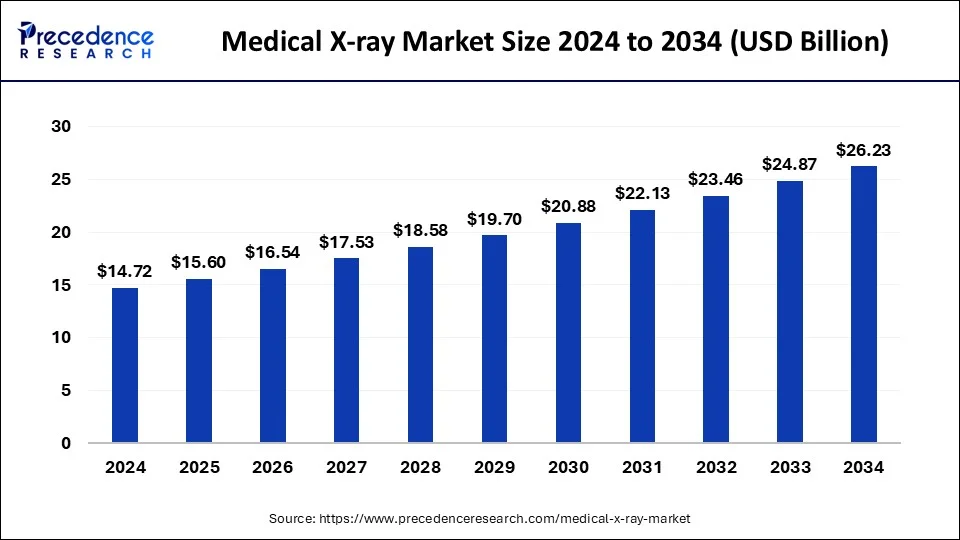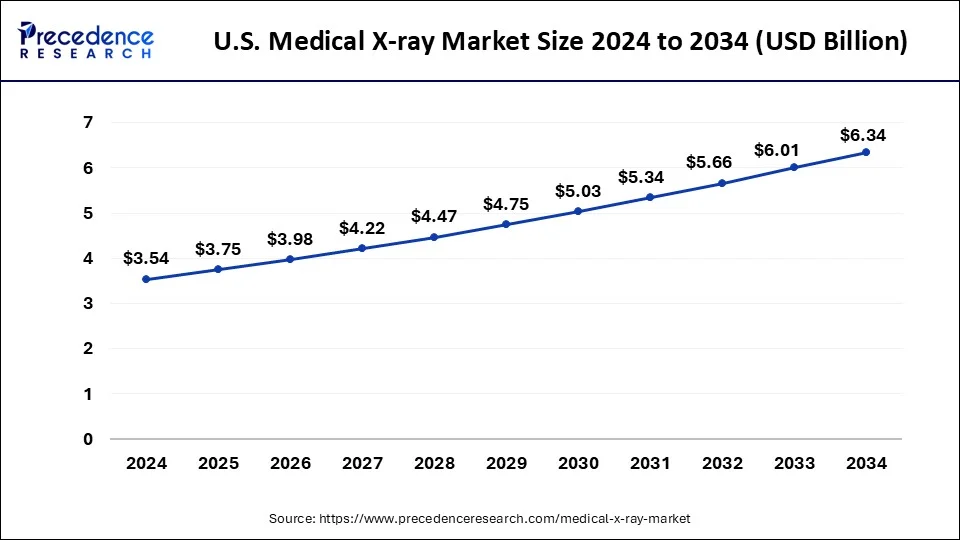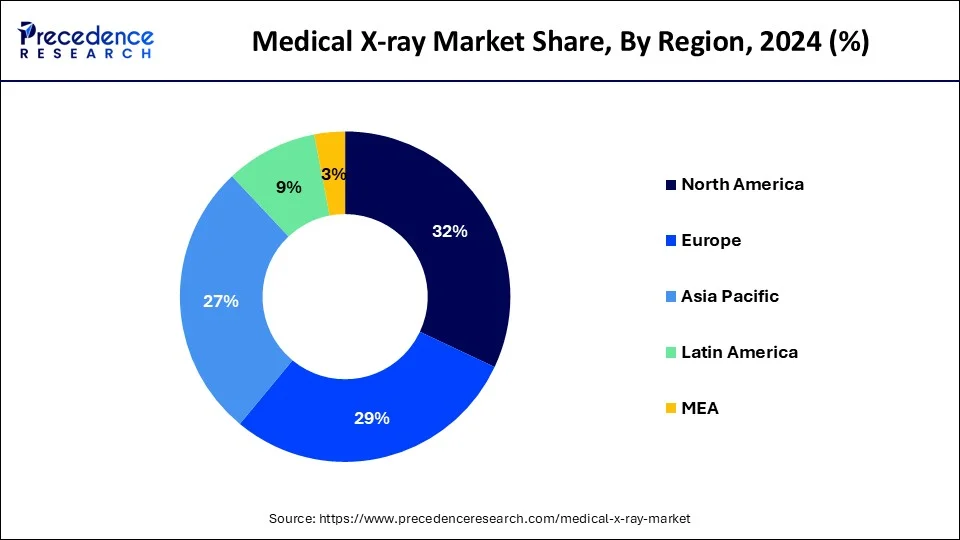January 2025
The global medical X-ray market size is calculated at USD 15.6 billion in 2025 and is forecasted to reach around USD 26.23 billion by 2034, accelerating at a CAGR of 5.95% from 2025 to 2034. The North America medical X-ray market size surpassed USD 4.71 billion in 2024 and is expanding at a CAGR of 5.97% during the forecast period. The market sizing and forecasts are revenue-based (USD Million/Billion), with 2024 as the base year.
The global medical X-ray market size was estimated at USD 14.72 billion in 2024 and is predicted to increase from USD 15.6 billion in 2025 to approximately USD 26.23 billion by 2034, expanding at a CAGR of 5.95% from 2025 to 2034.

The U.S. medical X-ray market size was estimated at USD 3.54 billion in 2024 and is predicted to be worth around USD 6.34 billion by 2034 at a CAGR of 6% from 2025 to 2034.

North America held the largest market share of 32% in 2024, leveraging advanced technology and robust healthcare infrastructure. Medical X-rays play a pivotal role in diagnostic imaging, allowing healthcare professionals to visualize internal structures and detect abnormalities within the body.
X-ray technology, whether projected onto film or transmitted digitally to computers, enables comprehensive imaging of internal organs, tissues, and bones. The dense nature of bones results in their appearance as white on X-ray images, while less dense tissues appear dark as the radiation passes through them. Medical X-rays facilitate the detection of broken bones, tumors, and foreign objects, enhancing diagnostic accuracy and treatment planning.

The region's commitment to leveraging medical X-ray technology extends beyond traditional X-ray examinations to encompass a spectrum of imaging modalities, including CT scans, mammograms, and fluoroscopy. This comprehensive approach to diagnostic imaging underscores North America's position as a global leader in healthcare innovation, driving continued growth and advancement in the medical X-ray market.
X-ray technology, discovered in the late 1800s during the era of electricity experimentation, has evolved into a vital tool for medical diagnosis and industrial inspection. X-rays, a form of ionizing radiation, penetrate through objects, including the human body, allowing for noninvasive imaging of internal structures. This low-cost and powerful technology has seen extensive use in medical diagnostics and industrial nondestructive inspection.
Advances in X-ray detectors and imaging applications continue to enhance their technological importance and effectiveness in various fields. Natural background radiation sources, including extraterrestrial and terrestrial origins, contribute to the overall radiation exposure, but medical X-ray machines emit controlled radiation for specific purposes, with proper precautions to minimize risks associated with genetic damage.
| Report Coverage | Details |
| Global Market Size in 2025 | USD 15.6 Billion |
| Global Market Size by 2034 | USD 26.23 Billion |
| Market Growth Rate from 2025 to 2034 | CAGR of 5.95% |
| Dominated Region | North America |
| Base Year | 2024 |
| Forecast Period | 2025 to 2034 |
| Segments Covered | By Type, By Portability, and By Application |
| Regions Covered | North America, Europe, Asia-Pacific, Latin America, and Middle East & Africa |
Drivers
Advanced imaging technology
The integration of traditional X-ray technology with computer processing, as seen in computed tomography (CT), is a significant driver of growth in the medical X-ray market. CT imaging surpasses plain radiography by providing highly detailed cross-sectional images of the body, offering doctors the ability to visualize internal structures from multiple perspectives.
Advanced imaging technological advancement enhances diagnostic capabilities, allowing for more accurate and comprehensive assessments of various medical conditions. As healthcare providers increasingly prioritize advanced imaging modalities for improved patient care and treatment outcomes, the demand for CT scans continues to fuel the expansion of the medical X-ray market.
Enhanced diagnostic capabilities through fluoroscopy and mammography
The utilization of advanced techniques such as fluoroscopy and mammography significantly propels the growth of the medical X-ray market. Mammography, utilizing X-rays, provides essential tools for cancer detection and diagnosis by identifying irregular-shaped masses and microcalcifications, aiding in early detection and treatment planning.
Fluoroscopy, which combines X-rays with a fluorescent screen, enables real-time imaging of bodily movements and diagnostic processes, such as tracking contrast agents through blood vessels and organs. This technology is vital in minimally invasive procedures like cardiac angioplasty, enhancing precision and effectiveness while fostering the expansion of the medical X-ray market through improved diagnostic capabilities and treatment outcomes.
Restraints
Potential health risks associated with ionizing radiation
Despite their diagnostic benefits, the medical X-ray market faces a restraint due to the potential health risks associated with ionizing radiation. While X-ray scans are a vital part of the diagnostic processes of life-threatening conditions such as bone cancer, blocked blood vessels, and infections, cumulative exposure to ionizing radiation poses a risk to living tissue. Although the risk of developing cancer from radiation exposure is generally small, the concern over long-term health implications limits the widespread adoption of X-ray procedures, leading to cautious utilization and potentially constraining market growth.
Concerns over radiation exposure in vulnerable populations
A significant restraint in the medical X-ray market arises from concerns over radiation exposure, particularly in vulnerable populations such as pregnant women and children. While X-rays are generally considered safe for pregnant women if the imaging area excludes the abdomen or pelvis, doctors prioritize non-radiation imaging modalities like MRI or ultrasound whenever possible. However, in emergencies or when time constraints exist, x-rays may be used as an alternative.
Children, being more sensitive to ionizing radiation and having a longer life expectancy, face a higher relative risk of developing cancer from radiation exposure. Parents may hesitate to opt for X-ray imaging unless assured that the equipment settings are adjusted for pediatric patients, thus limiting the adoption of X-ray procedures and potentially constraining market growth.
Opportunities
Advancements in X-ray imaging driving multifaceted applications
The continual advancements in X-ray imaging present significant opportunities for the medical X-ray market. With its exceptional penetration ability, X-ray imaging has become a powerful modality for medical diagnostics, enabling detailed visualization of skeletal structures, fractures, bone diseases, and foreign objects. This imaging data plays a crucial role in guiding surgical interventions and enhancing patient care and treatment outcomes. Moreover, beyond medical applications, X-ray imaging finds extensive use in non-destructive industrial and safety inspections, further expanding its utility across diverse sectors.
The continuous development of X-ray imaging technologies over the past century has not only revolutionized medical diagnostics but also contributed to advancements in various disciplines, ranging from fundamental research to practical applications. This interdisciplinary synergy creates opportunities for innovation and growth in the medical X-ray market, driving the evolution of diagnostic radiography and expanding its impact across multiple domains.
Advancements in digital X-ray imaging enhance diagnostic capabilities
The transition from traditional film-based X-rays to digital X-ray imaging represents a significant opportunity for the medical X-ray market. Digital X-ray systems, leveraging flat-panel detectors or charged-coupled devices (CCDs), deliver substantially improved image quality characterized by superior clarity, resolution, and contrast. This enhanced clarity enables healthcare professionals to discern even the smallest anatomical details with precision, facilitating more accurate diagnoses and optimal treatment planning.
Superior quality of digital images facilitates the early detection of diseases and abnormalities, potentially leading to life-saving interventions. The seamless integration of digital X-ray imaging with Picture Archiving and Communication Systems (PACS) further enhances opportunities by providing a comprehensive database for storing and sharing medical images and patient data across healthcare facilities or departments. This integration streamlines workflow promotes collaboration among healthcare providers, and ultimately improves patient care, driving the growth and adoption of digital X-ray technology in the medical X-ray market.
The digital segment stood as a cornerstone in the medical X-ray market in 2024, driving significant advancements through its transformative capabilities. One of the major breakthroughs of digital technology lies in its ability to facilitate the electronic transfer of images to any location, offering unparalleled convenience and accessibility. Digital X-ray systems deliver detailed images with remarkable efficiency by leveraging a combination of software and hardware. The system's sensors swiftly process and transmit pictures to a monitor within seconds, providing physicians with quick and clear insights into the patient's condition.
This timely production and transmission of images not only expedites diagnosis but also enhances collaboration and consultation among healthcare professionals. The option for remote interpretation of images holds immense potential in alleviating the workload of radiology departments, particularly during peak hours or in understaffed facilities. Images captured in one location can be swiftly analyzed and reported by fully staffed departments elsewhere, optimizing resource utilization and improving patient care.
Digital radiology represents a monumental leap forward in medical imaging, potentially rendering traditional radiographic films obsolete in the near future. Analogous to the transition from film cameras to digital cameras, digital X-ray technology enables immediate image acquisition, editing, and sharing across a network of computers. This transformative shift not only enhances workflow efficiency but also enhances diagnostic accuracy and patient outcomes, positioning digital X-rays as a cornerstone of modern healthcare imaging practices.
The fixed systems segment emerged as the dominant segment within the medical X-ray market in 2024, primarily due to their ability to streamline workflow for technologists, enhance consistency, boost diagnostic confidence, and minimize errors. Designed to keep radiology departments running smoothly and profitably, fixed X-ray systems are equipped with features aimed at simplifying operations and ensuring optimal performance.
Conventional radiography machines, a subset of fixed X-ray systems, are widely prevalent in hospitals and medical facilities. These machines, comprising an X-ray tube, flat detector, or film cassette, excel at capturing static two-dimensional images, making them well-suited for imaging bones, joints, and the chest. Conventional radiography plays a crucial role in diagnosing fractures, dislocations, and lung infections and evaluating bone health, among other applications.
In the market, the portable systems segment is expected to gain significant traction in the upcoming years. While fixed X-ray systems offer unmatched reliability and efficiency, the rising demand for portability in medical imaging presents a notable consideration. Portable X-ray systems provide flexibility and accessibility, allowing healthcare professionals to conduct imaging studies at the point of care, such as bedside examinations or in emergency situations. The portability of X-ray systems enables enhanced patient care and facilitates timely diagnoses, particularly in scenarios where mobility is essential or traditional imaging facilities are inaccessible.
The chest segment captured the biggest market share in 2024, owing to its widespread application and diagnostic efficacy. Utilizing a minimal dose of ionizing radiation, chest X-rays generate comprehensive images of the heart, lungs, airways, blood vessels, and spinal and chest bones, making it the most commonly performed diagnostic X-ray examination.
This imaging modality plays a pivotal role in diagnosing and treating various medical conditions by providing crucial insights into internal anatomy and pathology. By exposing patients to a small dose of ionizing radiation, chest X-rays aid healthcare professionals in diagnosing conditions such as shortness of breath, persistent cough, fever, chest pain, or injury. Moreover, they facilitate the evaluation and monitoring of lung-related ailments, including pneumonia, emphysema, and cancer.
As the oldest and most frequently utilized form of medical imaging, chest X-rays offer a fast and convenient diagnostic solution, particularly in emergency settings. Their rapid acquisition and ease of interpretation make them invaluable tools for swift diagnosis and treatment planning, enhancing patient care outcomes, and optimizing healthcare delivery.
By Type
By Portability
By Application
By Geography
For inquiries regarding discounts, bulk purchases, or customization requests, please contact us at sales@precedenceresearch.com
No cookie-cutter, only authentic analysis – take the 1st step to become a Precedence Research client
January 2025
March 2025
August 2024
January 2025